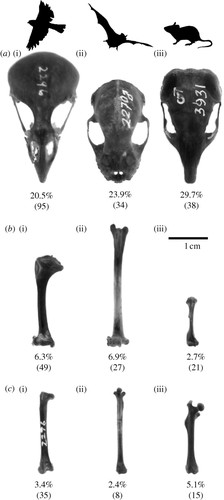Bird skeletons are generally described as lightweight as a result of choices to minimize the energy required for flight. By analogy, the increased bone density of birds and bats may reflect adaptations to maximize bone strength and stiffness while minimizing bone mass and volume. 17 minutes. 2010г. Bird skeletons are generally described as lightweight as a result of choices to minimize the energy required to fly. From a functional point of view, the animal's weight (mass) relative to the surface that produces lift is an important determinant of the metabolic cost of flight. Why do birds have hollow bones? Birds fly very well because they have a particularly light and strong skeleton. Most of these bones are hollow, with webs inside or honeycombs with fine girders of bone for added strength. They are also called "pneumatic" or air-filled bones. The difference between birds and mammals is relatively easy to see at a glance, but there are some differences that you may not know. Birds differ from mammals in that they have feathers, lighter bone structures, feeding methods, respiratory, circulatory, and digestive systems. Instead, the bird has a number of large dilations called "air sacs," which are hollow (pneumatic) bones, all interconnected to the lungs. These allow the air to flow in a magnificent circle. This means that birds can always have fresh, oxygen-rich air in their lungs.
Bird skeletons are generally described as lightweight as a result of choice to minimize the energy required for flight. From a functional point of view, the animal's weight (mass) relative to the surface that produces lift is an important determinant of metabolism. Flight cost.
Why do birds have a lightweight skeleton?
Bird skeletons are generally described as lightweight as a result of choices to minimize the energy required to fly. From a functional point of view, the animal's weight (mass) relative to the surface that produces lift is an important determinant of the metabolic cost of flight.
Why do birds have hollow bones?
Birds have hollow bones because they are theropod dinosaurs. Hollow air-filled bones have evolved in sauropods and theropods. Lightweight but very strong bones are the reason why sauropods were able to reach huge sizes. Their bones are much stronger and denser than mammalian bones, but they do not weigh.
How can you tell the difference between mammalian bones and bird bones?
Find isolated bird bones and compare them to mammalian bones of the same size. Birds have pneumatic (air-filled) bones. Space can occupy most of the volume of bone. In mammals, bone is generally hard or filled with bone marrow.
Do birds have bones in their lungs?
(There are also some aerated bones, mainly around the sinuses). According to Matt Wedel of the University of California, Berkeley, as a baby bird grows, the air sacs that make up its lungs "invade" its bones, forming a bunch of small depressions. The air sacs remain attached to these depressions for the life of the bird.
Why do birds have hollow and light bones?
Hollow bone, also called aerated bone, means that it is filled with space for air. This structure is believed to help ingest oxygen during flight. .. Bird bones are denser. This density makes these thin, hollow bones hard and strong so they don't break. 2018
Why are bird bones so dense?
The bones of flying birds are thinner than other animals. Bird bones are thin and denser than flightless animals of comparable size to maintain the strength needed to cope with the enormous physical load exerted during flight. 2019г.

Below you will find two helpful answers on a similar topic. 👇
What is a bird arm used for?What vegetables can't rabbits eat?
